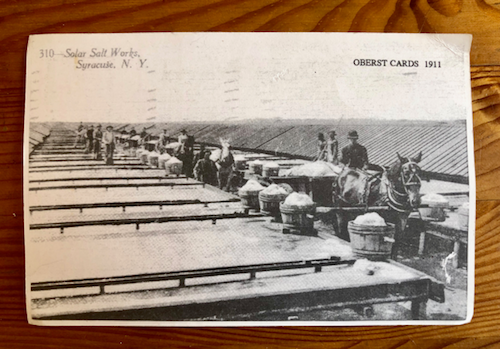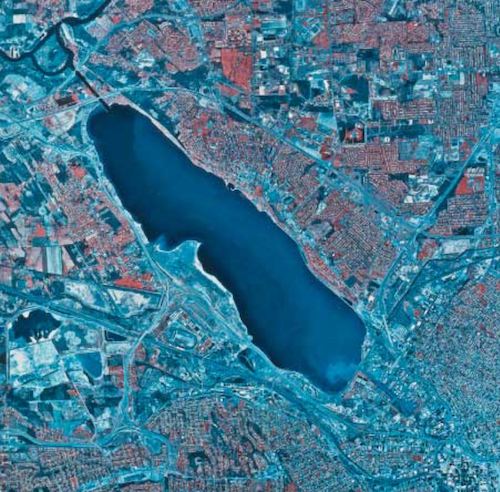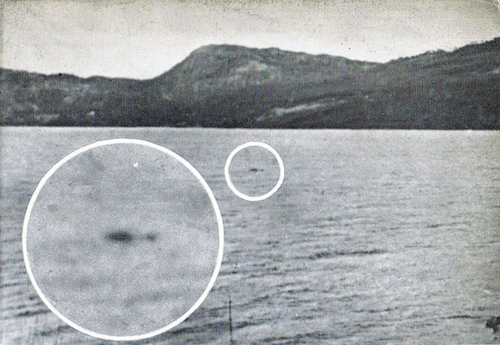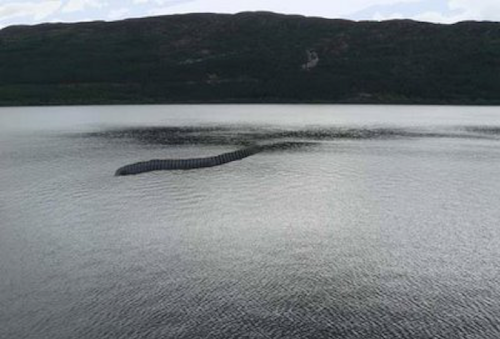The Work, the Edit, the Water: Coming to Terms With Editing Out

A version of this essay was delivered as a talk as part of the “‘We have left our broken house in ecstasy’: Ecopoetics Through Travel” panel at the Conference on Ecopoetics at University of California—Berkeley (February 2013).
***
Some years ago, I thought I had finished a book-length poem. It documented a series of aggressive motions made toward my mother, often by strange men. These actions moved into her realm of privacy and security very quickly, nearly in tandem, and her being alone in her home gave them a particular urgency. I yoked these events with information surrounding a large lake nearby: Onondaga Lake, one of the most polluted bodies of water in the United States. The lake was a constant source of chaos in the collection—killing people through drowning or storms and, eventually, due to industrial production and waste dumping, through poisons leaching into the local water, earth, and fish. Thinking of the number of unclaimed bodies that line its floor is wholly unnerving, the living bodies it continues to poison. Since being polluted so extensively, one cannot look into the face of it and see deeper than three feet. Researchers have pulled out cars, broken dishes, barges. So what exactly the lake contains generally remains an unknown. Through the writing of the book, the mystery of the lake and the mystery of the aggression toward my mother have since pleated together in my mind. You can imagine the dark thrill I felt when, being completely ignorant of ecofeminism and having written a draft of the manuscript, I read Cheryll Glotfelty’s essay in which she describes the pursuit as “a theoretical discourse whose theme is the link between the oppression of women and the domination of nature.”
*
After the publication of a manuscript, one often doesn’t speak about what is lost in the process. I mean this in a literal sense—the pieces cut, lifted, left out. The manuscript described above was once called “The Lake Was Perfectly Calm,” then it became “Seiche” and was “Seiche” for many years before being incorporated into my collection Playing Monster :: Seiche. The result of this folding in of the two books into one involved editing out the pieces that made it an explicitly ecofeminist text. After not one, but two, readers I trust suggested I put the two manuscripts together, then in the face of my uncertainty a third friend telling me, “You know what they say—three people call you a horse, it’s time to buy a saddle,” I heeded suggestion. Another friend helped me edit (for every book takes a village), and I found there wasn’t room for the ecofeminism anymore. This was hard for me to stomach. I was at a residency, processing the excision—and it filled me with grief. While as a single work Playing Monster :: Seiche is far more powerful, these manuscripts felt, and still feel, so distinct in my mind. Making them one left an emotional specter for me. The published text moves between the two works, with a gentle guide for the reader at the bottom of each page pointing to whether the above is a “Playing Monster” or “Seiche” poem—but most people hardly seem to notice, as the book so clearly seems to be one form, one fabric. (Together they make a different kind of statement, particularly about abuse and aggression and how it resurfaces again and again in life, even after you think you have escaped it elsewhere.) So this is a little space of mourning for that book, and the joy of research and ecopoetics it allowed me to explore.
*
Put most directly, a seiche is a wave. What makes it special, requiring its own name, is that it never crests and falls. It moves across bounded bodies of water and pushes forward, eerily. Or everything is tipping, lurching, slowly.
Seiches occur all over the world. They are in lakes, swimming pools. You may see one, or have seen one. Earthquakes often provoke them, people pointing their cameras on the strange seesawing shapes in nearby water.
In French, it is the word for “cuttlefish,” which I attribute to the movement of their fins—an endless seiche rippling around the little brilliant body.
*
The area where the “Seiche” poems take place, Central New York, is an area where I lived for only a year. One of my first memorable experiences there was going to the local historical museum on a field trip and seeing some of my stranger-peers clustered and looking at an old framed engraving on the wall. It was a vision of the future from the 19th century, a projection of the city as it may potentially develop. There was the pale blue lake, the locus around which businesses and homes circled outward. It was never developed in such a way, as the pollution of the lake was swift and brutal, the area surrounding it now relatively deserted. My peers were all laughing to one another, at the irony that over a century ago developers believed that this now-polluted lake would act as the center of the city. I, of course, had no idea what they were laughing at, as I knew nothing of how the cityscape was ultimately built. So they explained, and the ominous existence of this polluted entity became one of my first pieces of local knowledge. I remember someone telling me of sitting in a boat on the lake and her thermos slipping out her hands and into the water. Though it bobbed close by at the surface, she could not bring herself to reach in and retrieve it. People who eat fish from the lake are generally regarded as brash or ignorant. There is a stench when you drive by.
My initial sense was that locals mostly considered the lake a strange presence in their proximity, and nothing more. Research gave me greater insight. As a saltwater lake, it proved to be one of the most valuable assets in the northeast prior to the invention of electric refrigeration, as salt was the most prevalent means of preserving meat. The salt is what spurred the city’s development, made it a city at all. The men who harvested the salt from this lake worked 12 hours a day, seven days a week. They were considered to hold posts so important they avoided conscription in the Civil War. The saltworks were in operation for over a century. There is a little museum at the lake’s edge. I went, long after the “Seiche” manuscript felt done, and bought myself a memento. An early-20th century photograph postcard of horses pushing carts of salt forward down a lane of troughs for airing out the salt in the rare Syracuse sun.
The lake was a resource for local American Indian tribes before it was claimed, harvested for other resources, and then used as a dumping site by whites. It was the place where Hiawatha canoed across to meet with the chieftain Tadodaho for the peaceful formation the Five Nations of the Iroquois in 1142. This historic site was where companies and the city dumped soda ash and sewage. It is now a “toxic stew” of over 165,000 pounds of waste, labeled a Federal Superfund site for its extensive contamination. The price tag of the cleanup ranges from $450 million to $1 billion. The tribes have recently attempted to speak out against the horrible pollution and even regain the lake and the land by legal means, but to no avail. There is a record.
*
I am an outsider in the town and, once the aggressive gestures toward my mother all began, I became a kind of investigator, trying to learn as much as possible about this place. Research became a key to my writing, too, with found-text poems drawn from newspapers acting as a kind of lattice for the manuscript to unfurl. There were collage pieces from late-19th century articles—a few of which survived the Big Edit—as well as more contemporary texts about the modern reckoning with the pollution. These articles proffered information on the deaths on the lake through drownings, the poisons in the lake and subsequently in locals through dumping.
As I wrote poems about my mother, and thought and learned more about ecofeminism, I began to think of the lake as exerting a kind of aggression. This can be read a few ways—and I read them at two entirely different slants, depending on my mood. One being: this is a toxic environment, where even the inanimate are involved in the destruction of the innocent—for those responsible for dumping the waste did not drown in the lake, did not live long enough to eat its toxic fish. It is a polluted monster created by local white businessmen over a century ago that continues to haunt and harm the place. I distinctly remember a reader of a draft telling me it was as if she were reading the phrase “It’s poison!” over and over.
SEVERE STORM AT SYRACUSE
—
Several Persons Believed to Have Been
Drowned in Lake Onondaga—Much
Damage to Property
AUG. 28, 1895
And wind and rain
of terrific violence
swept over this city
Many chimneys thrown down
trees and score torn up
Onondaga Lake covered
with boats filled
with pleasure seekers
one contained two fish
freshly caught
three fishing poles
The anchor was dragging
(unpublished poem from “Seiche” manuscript)
Yet an alternate, and often more appealing, construal recognizes the lake is a feminine entity, enacting retribution on the population that slowly encroached upon and marred her existence—in turn performing an aggression that my mother could not despite the similar bent of their narratives. Carolyn Merchant writes, “The narrative of frontier expansion is a story of male energy subduing female nature.” Though Merchant is focusing specifically on the American West, this is arguably the case for most of “tamed” parts of the United States and the world.
Five miles long and a mile wide, a bit uncertain at its edges. The lake, when seen from a bird’s eye view, is vaginal. Its mystery and the inability for a person to penetrate it with gaze proves this to me, somehow. Instead of being “subdued,” as Merchant puts it, the lake has engaged with its oppressor. It began by taking in bodies from the white population that destroyed it and, when people avoided even going on the lake in boats, poisoning them with the very toxins they put in it through the fish and water supply. (The indigenous tribes no longer had much access to the lake after whites claimed it, mined the salt, and dumped soda ash there.) Some scientists recently added a red dye tracer to the lake to observe its reaches, and were horrified to see the red toxic flow bubble up in nearby “clean” creeks and lakes—lakes filled with swimmers all summer. The lake wielded the agency it was given: its permeation, depth, toxins, and proximity to those who abused it. In this reading, the land is no enemy. It underscores the kinship between what my mother and the lake both sustain and their disparate modes of response. One is violent (the lake), the other trying merely to be forgotten by those inflicting aggressive acts upon her.
Prior to the Big Edit there were also poems about the company that inherited the responsibility for the dumping—the company called to complete a massive dredging up the lake, lay a gravel and sand cap across its floor. There were lists of things researchers discovered in its muck. The historical indigenous events that took place on its surface and shores. The proclamation of its being safe for fishing and swimming, the mayor and locals jumping in to much fanfare—only to have the announcement retracted not long after. Poems on this landscape, marred, which simultaneously obscures through its depth and opacity, and bears up again and again for anyone willing to touch, test, observe.
*
Mary Daly writes: “For anyone who has retained a Primal Memory of connectedness with the Wild, the thought that she could be severed from this—or that the Wild itself could be destroyed—stirs ineffable feelings of horror.” These “ineffable feelings of horror” are akin to a different kind of destruction in my case—that of my mother. My poetry allowed me to be there with her, in a way—to engage with a situation in which she (and I) were relatively helpless. Without my creative and psychic attempt to be “present” in a way across the country, there was little more I could do than just absorb the events as they unfolded.
Anyone who creates work that touches on the personal can tell you there is frequently an inner push to scratch out material on moments that leave you feeling impotent. This ranges from explicit abuse to a frustrating random encounter with a stranger. The page can be a space to set all the ugly feelings these experiences provoke, provide some psychic recourse. This manuscript was my means of response to a situation in which I could, ultimately, do nothing. But, like most people who engage in creative output, nothing wasn’t really an option. The poems allowed me to push my worry around, reach out to my mother, document what was happening, try to understand the space in which she lived, moved—and was endangered—more fully.
*
I recently came upon a piece of knowledge that links these two manuscripts in my mind more tightly than ever before. A seiche can produce a single ripple so large and strange to those who see it from afar it registers as unknown, as danger, as animal—as monster. This is the theory for the lake monsters, Champy in Lake Champlain and Nessie in Loch Ness. What we try to see when we can’t see much at all, or recognize as something we can comprehend. We name it, send experts after it, train our sad little human tools where we thought we saw movement, scan to understand what we can never touch.
Diana Arterian is the author of the poetry collection Playing Monster :: Seiche (1913 Press, 2017), …
Read Full Biography





